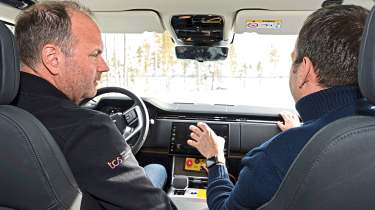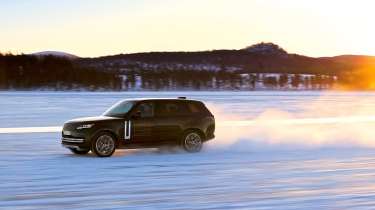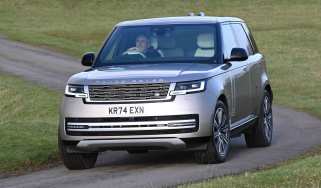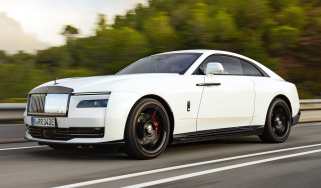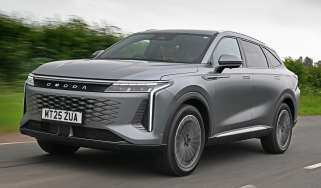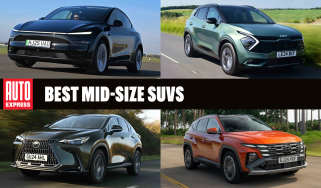New Range Rover Electric ride review: luxury EV could be worth the wait
We get taken for a ride in the hotly-anticipated all-electric Range Rover ahead of its official reveal
Land Rover is known for its exhaustive, almost obsessive levels of development, so it comes as no surprise to see that the brand isn’t taking any shortcuts with the new Range Rover Electric. Due to be revealed in full later this year, and on sale soon after, this expensive and elegant off-roader has the weight of being the brand’s first electric car on its shoulders – explaining why the team responsible are leaving no stone unturned in the car’s journey to production.
We joined Thomas Müller, Head of Development at Jaguar Land Rover, and chassis guru Matt Becker, who is responsible for the driving dynamics of the entire fleet, in Arjeplog, Sweden, as the cold-weather testing program winds down ahead of another round of testing in the deserts of the Middle East.
We’ve known about the existence of an electric Range Rover for some time, but even though there are countless electric SUVs on the market, few of them are genuine luxury SUVs. Not many manufacturers have yet electrified a true off-roader, either, so Müller and Becker didn't want to make any compromises.
"First and foremost, this is a real Range Rover and only secondarily an electric car," says Muller. As we found on the road, this is easy to achieve, because electric drive is perfectly suited to the luxury class, with its effortless power delivery and almost eerie silence.
The heavy battery in the floor also plays into the developers' hands, because it lowers the car’s centre of gravity while increasing its rigidity, ensuring even more sublime composure. In a way that only the Rolls-Royce Spectre can emulate, the Range Rover Electric becomes the ultimate quiet limousine. As a passenger, we feel as though we're nestled in clouds and wrapped in cotton wool, as we're beamed through the Swedish winter landscape on a leather throne.
Used - available now

2020 Land Rover
Range Rover
35,304 milesAutomaticDiesel3.0L
Cash £41,000
2018 Land Rover
Range Rover
35,463 milesAutomaticDiesel3.0L
Cash £35,000
2021 Land Rover
Range Rover
49,250 milesAutomaticDiesel3.0L
Cash £42,561
2021 Land Rover
Range Rover
34,148 milesAutomaticPetrol2.0L
Cash £37,995Off road, on the other hand, an EV powertrain is both a blessing and a curse. Its advantages start with the fact that its power can be regulated much more precisely than with a combustion engine. The downside is that it can be all-too-immediate, not matching the effortless ease with which a petrol Range Rover usually ploughs through mud or snow.
To achieve a more measured delivery, the drivetrain’s computers need to adjust the motors and traction control systems in anticipation of the conditions – something they do with a level of success even in this prototype vehicle.
It pulls away without a single lurch or scrape, even on polished ice or through deep snow and ruts. It can do this with one-pedal driving or the smart off-road cruise control on slippery slopes or climbing steep ramps – even when one side is on asphalt and the other on an icy track.
As if all this weren’t enough to give Müller and Becker considerable headaches, the battery, unlike other parts of the drive system, isn't so adept at climatic extremes. And this despite the fact that the Range Rover, more than most other cars, is actually used just as often in the desert as it is at winter destinations in the Rocky Mountains, the Alps, or even here in Sweden.
To combat this, the team at Land Rover have developed a sophisticated thermal management system that automatically selects the best compromise between interior comfort, charging speed, and range from 700 settings. And the heat pump can deliver energy even at -10 degrees Celsius.
The good news is that a BEV powertrain isn’t as complex to package as an ICE engine, meaning there’s no negative effect on other off-roading requirements. Fording depth, approach and ramp angles, and ground clearance are the same as, or better than, the regular car in most driving modes, Müller promises. And given that the existing PHEV models have a kerbweight of almost three tons, the EV’s few extra hundred kilos shouldn’t cause too much alarm for the air suspension.
Visually, there’s almost nothing to distinguish the new EV model from the existing Range Rover. This is because it doesn't use a dedicated electric platform, but rather a compromised hybrid architecture. Yet the company has – credit where credit is due – gone big with the drivetrain.
Neither a BMW iX nor a Mercedes EQS, and certainly not the Audi Q8 e-tron, can compete when Müller reveals the initial key performance data. The two e-motors produce 542bhp and 850Nm of torque, making the electric Range Rover the biggest powerhouse in the brand’s line-up this side of the performance SV model.
It runs on a cutting-edge 800-volt electrical system with a 117 kWh battery pack, which should enable a range of "well over 310 miles”. Charging is possible with 22kW AC and up to 350 kW DC. Just like a Porsche, it can bank charge by ‘virtually’ splitting the batteries into two 400V systems, helping it to top up faster than much of its main competition.
The only way you can tell that the Range Rover wasn't developed around electric drive is the absence of a frunk, because the space under the bonnet is still packed with hardware. However, one could still be carved in that space – after all, the car is still another nine months away from going on sale – which would make for a nice small storage compartment for the cable.
Yet Müller, Becker, and their team still have much to do, because even if they can hang up their winter jackets, the development program continues. It’s now time to head back into the heat of the desert, because the battery-powered drive still has to prove that it's in no way inferior to combustion engines.
Already, though, the forthcoming electric Range Rover feels confident, silky, quiet and incredibly powerful. The electric powertrain feels like a perfect fit for such a vehicle, where luxury is always more important than pure performance.
And because a Range Rover always has a bit of Defender in it, there are no compromises, even off-road. This will be an expensive affair, though, with production models almost certainly costing more than £120,000. But this is unlikely to bother customers. After all, they're already used to paying high prices for what’s always been – and on this account will continue to be – a national icon.
Click here for our list of the best luxury electric cars...


